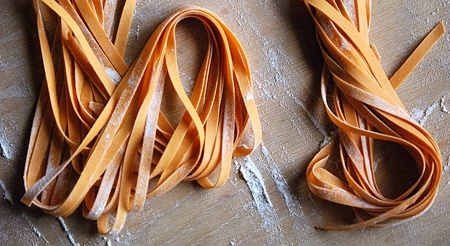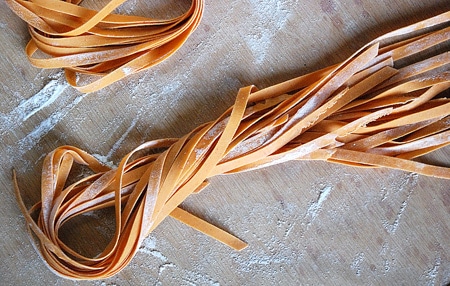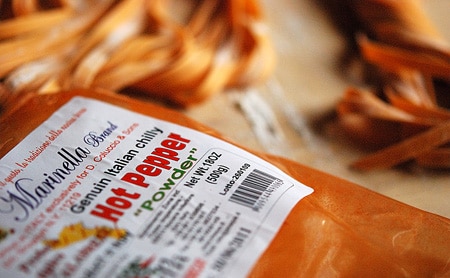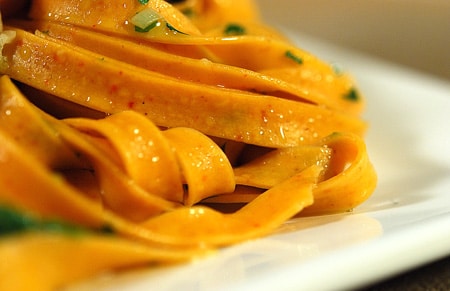As an Amazon Associate I earn from qualifying purchases.

I make pasta at home a lot, have been for years. It is a soothing process I find utterly absorbing: knead, roll, cut, fill, shape. Even after several hundred batches, homemade pasta still satisfies something elemental within me.
At its core, all pasta is flour and water. But its sum outshines the parts. When I look at row after row of freshly made pasta, I feel like I’ve done the impossible, that I’ve made something out of nothing. It feels like alchemy. And it is.
Over the years, as I have grown more skilled, pasta-making has become a larger journey that I see no end to — with endless combinations of flours and ingredients, both within the pasta and as sauce, as well as endless shapes, sizes and widths, each lending a distinct character to the finished product.
I make no pretense of being the best pasta-maker in the world. There are pasta skills that remain out of my reach, like rolling dough so gossamer thin you can read through it, armed with nothing more than a rolling pin and a hardwood board. But knowing that thousands of nonnas and zias and even Anglo cooks like me have mastered this seemingly magic ability keeps me going, like a martial artist training to reach a higher degree of enlightenment — and lethality.
That said, I’ve gone, trial-and-error style, through so many batches I think I finally have a few tips to offer on how to make first-rate homemade pasta.
I used to think one kind of pasta was pretty much the same as another. When I was in college, my girlfriend DeDee would always squinch up her nose when I cooked spaghetti; she only liked vermicelli with her tomato sauce. I rolled my eyes at her. “What’s the difference?” She couldn’t quite explain it, but stood firm. There was a difference to her.
DeDee was right. Vermicelli is thinner than spaghetti, more delicate. If you pay attention, you get a lighter mouthfeel eating a bowl of vermicelli (also known as spaghettini) than you do with the heftier spaghetti. I realized this fact sometime in my 20s.
At about the same time I discovered that ziti with ridges held sauce better and were also lighter than smooth ziti. And penne, which are ziti cut on an angle, catch sauce better than ziti, which are more suited to being baked in a casserole; the pointy end of the “pen” in penne funnels sauce the way the straight-cut end of ziti cannot.

Consider the long, flat noodle for a moment. At first glance, they all look roughly the same. Somewhere between eight inches long and two feet, they are all between a quarter inch and 5/8 of an inch thick, and pretty much the same width, right? Nope. Linguine is a thick pasta, while tagliatelle, which is similarly wide, is far thinner. Pappardelle is just as thin as tagliatelle, but twice as thick, sometimes more than 1/2 inch wide. They all feel different when you eat them.
You can see why Italians get real persnickety about which sauce goes with which noodle. For the record, thin pasta like spaghetti needs a smooth sauce. Thick pappardelle is normally served with chunky wild game sauces.
All this is just a primer on why the Italians developed several hundred pasta shapes. Every day I am learning about new ones, thanks to an amazing book — fittingly called the Encyclopedia of Pasta — that goes into the details of all these shapes. But what about the ingredients in the pasta itself?
Start with flour. I used to think all fresh pasta was made with “regular” flour, as in all-purpose. Wrong. Many of the most delicate pastas are made with something called “oo” flour, which is ground finer than all-purpose. Then there is semolina, another variety of wheat that is harder than common flour; it’s used in fresh pasta made in Southern Italy. Again, the fineness of the grind matters enormously, which is why buying Italian semolina matters.
I am now getting my standard flours imported from Italy, courtesy of Scott Stegen, who runs the blog Sausage Debauchery. Scott works for an importer who has allowed him to set up an online store; you can see links to his eBay store in various places around this site. I can vouch for his stuff — it’s the real deal, down to the Calabrian red pepper powder for the spicy salami nduja that is so in demand now.

I used some of that red pepper powder to make an unusual pasta. I’d dimly been aware that Italians will sometimes put chiles in their pasta dough — although “adulterating” dough is controversial in Italy, depending on which region you’re talking about. Some scoff even at the use of chopped, cooked spinach to make that very traditional green pasta. But I’d since seen recipes for hot pepper pasta both in the south of Italy (Calabria, Puglia and the like), as well as in Tuscany. My recipe for the spicy pasta is an amalgam of both Calabrian and Tuscan recipes.
Different flours make huge differences. Scott’s “oo” flour is far smoother than even the King Arthur all-purpose I’d been using. I’m looking forward to using to make some delicate, egg-heavy pastas down the road.
Using grains other than wheat creates even flashier effects. You will see a lot of alternate-grain pastas on this site because I cook so much wild game. Adding rye, barley and spelt to pasta gives it a more rustic feel. Scott is trying to find me something called grano arso, which is flour from toasted — almost burnt — wheat. It was historically something only the poorest of the poor used, but it is now used by artisanal pasta-makers as a way to reconnect with the past. Can’t wait to experiment with it!
I kick up the rustic factor even further by adding more “adulterants” to the pasta dough — typically chestnut flour, chickpea flour and more recently, acorn flour. All add a lot to the pasta’s flavor, but make the dough more difficult to bring together because none of these flours has any gluten; I combine them with higher-gluten bread flour when I make these pastas.
The Final Frontier with flours will be grinding my own. I do not yet have a flour mill, but I reckon it is only a matter of time. Flour is incredibly stable, but it will go stale over time; this is why many flours (rye and barley in particular) are best stored in the fridge. Ever smell fresh-ground flour? It is every bit as intoxicating as fresh-ground coffee.
Yet even if you stick with regular old flour and make regular old pasta, there is still nuance in the making of it.
How much liquid? Eggs or no? And if so, how many, and will you use whole eggs or just the yolks or whites? There is a decadent pasta called tajarin from Piemonte in Northern Italy that has so many egg yolks in it they designed another pasta with just the whites called “sheets and linens.”
Will you add oil? What about salt? I add salt almost always, but just a pinch. Why? Because fresh pasta cooks so fast it barely has time to absorb salt from the water. Olive oil will find its way into my pastas, but usually because I coat the kneaded dough with it before letting it rest for an hour — and I never make pasta without letting it rest at least an hour. This is important for hydrating the flour, as it takes time for it to absorb the liquid. Long resting times are absolutely vital with flours like acorn, chickpea and chestnut. I will often rest pasta with these flours for half a day.

When do you want a “wet” dough and when do you want a dry one? Some doughs are so dry they are very difficult to knead, while others are so sticky they are tough to keep from attaching themselves to your board.
I use wet doughs with filled pasta like ravioli because I want the pasta supple during the relatively long time it takes me to fill them. I use dry doughs with long-cut noodles like tagliatelle and spaghetti. If I had a pasta extruder (another thing on my to-do list) a dry dough would be more appropriate there, too. Generally speaking, you want pasta dough to be cool and soft and smooth — I always think of the way the inside of a woman’s forearm feels to judge whether my dough “feels right.”
I roll my pasta with a manual pasta machine; an Atlas, to be exact. I have never tested other brands, but my Atlas has served me well for a decade. I have used mechanized pasta machines, however, and I don’t like them. You cannot stop and start the machines easily, and I often stop to adjust things midway — this is exceedingly important with very thin pastas, or when your dough is wet, so you can keep everything from sticking.
As for gadgets, they have their uses. I’ve used ravioli rolling pins and they’re cool, but I generally cut mine by hand or use a stamp. I also have a chitarra, which is a box with wires stretched on it like a guitar. It creates tagliatelle-like pasta by laying a sheet of pasta on the wires and then rolling the pasta through with a rolling pin.
I could go on and on. And I will, later. Pastas are such a natural accompaniment to the kind of cooking I do that I plan on writing more about them as I go. To that end, I have created a special page with all my pasta recipes, where there are both recipes for pasta-making itself as well as pasta sauces for either homemade or store-bought pasta. Some recipes are simple, others baroque.
One reason I put all this out there is because I know there are a lot of very good cooks who read this space, many of whom make their own pasta. Care to spill your secrets? What gadgets do you use? Any pointers on a flour mill? Has anyone mastered rolling pasta with just a pin?

____________




I have a hand-crank roller that works a treat. My son loves to crank it while I feed/catch whatever we’re making. Lately I’ve been into unorthodox flavorings and colorings, like hijiki or beet juice. But it doesn’t matter- now matter how ugly, it’s better than store-bought by a country mile. Your ideas on other flours are inspiring…
Hank, I really think you’re going to enjoy Ratio given the amount of experimental cooking you do. Very curious to see what you think of it so please do post your thoughts after you’ve read it.
A nice trick for the Atlas is to take off the outer case pieces, along the rollers. They don’t serve any purpose, but they do get gummed up sometimes and cause swearing.
Nice post. I made worlds of pasta before the wife quit eating gluten. Together with the losses in pie crust and bread, one of the great tragedies of my life.
Try some experiments with chocolate pastas. They can be the ultimate dessert finish to a meal. The saucing can be everything from fudge sauce to strawberry to raspberry to almost any puree. A chocolate linguini with a homemade vanilla ice cream is a wonderful meal ending surprise.
I make pasta with whole eggs if I’m cooking it fresh, but egg yolks only if I’m filling ravioli to freeze. I find that whole-egg pasta tends to turn brittle in the freezer.
Unfortunately, this always leaves me with way too many leftover egg whites. I could probably use a recipe for “sheets and linens!”
Nick: I can’t quite remember, but I bought the chitarra online. I think it was from Creative Cookware…
Another great post! And Holly! Those photos made me hungry right after dinner
What I want to know is: where did you get a chitarra? I’ve looked around, and the only one I’ve found for sale is on the williams-sonoma website.
Lisa: Yer killin’ me! Tell me you knead yourself once in a while at least… 😉
Deanne: I plan on messing around with it soon. I will take your tips, give it a go and post back on what happened.
Chris: Is your Marathon mill a hand crank or machine? I kinda want a hand crank, but because I am something of a Luddite (Shocking, I know… ) but also because you can better grind small amounts with a hand mill. I think.
Kirsten: Milk, huh? Never done that. I have heard of it done, especially in sweet dessert pasta. It really helps the elasticity? Any idea why? And that is a wild old pasta cutter!
Mfree: White pepper in the pasta itself? It must be very, very finely ground. I tried black pepper once and the grains broke the gluten in the pasta dough.
Mark: OK, you’ve finally given me a reason to buy Michael’s “Ratio” book. Will be interesting to see what his ratio of moisture to flour is, and if it holds up with varying ingredients…
Kate: Great story! And I have *very* warm hands, so that bodes well for me, too!
Annie: Scott is good people. What do you have in mind for your venison?
Killgore: Weird. Sounds like a gnocchi my friend Garrett makes. What shape do you make them into? I’d think the sweet potato would wreak havoc on the gluten in a long noodle.
Cindy: Thanks for the kind words!
Wow, your pasta looks a lot better than mine ever did! Thanks for all the great resources and tips, I may just have to try it again.
I enjoy making sweet potato pasta. Bake a medium sweet potato (or nuke in the microwave for 7-8 minutes) until cooked completely through. Allow it to cool and the skin will come off easily. Make sure your sweet potato is completely cooled before mix with eggs and flour. You can put it in the fridge to speed things along. Once cooled mix the sweet potatoes, egg, flour ( I use semolina) and a pinch of salt. You will need to account for a little extra flour in your recipe because there’s moisture in the sweet potato.
It adds a lot of nutritional value and fiber to regular pasta and it’s delicious.
I like your idea of adding red pepper. I’ll give that a try with my sweet potato pasta.
great post, thanks! And that sausage debauchery?! You may have just ruined me. We discovered a full additional 20 lbs. of venison from the last month of the season, so we still have plenty more to work with!
Calling the Italian persnickety about pastas, pasta shapes, pasta fillings, and the appropriate sauces thereto is an understatement. I encountered a facial expression of genuine horror when discussing with a resident of Modena what Americans will put in a pasta wrapper and call tortellini. I was told that only barbarians would do such things. And I discovered the joy of ropy, chewy strangozzi noodles, lightly graced with a tomato and cinghiale sauce in Norcia, or other tomato-y sauces elsewhere in Umbria.
Your pasta looks gorgeous, Hank. I’ve rolled pasta with just a pin once or twice, with the help of an Italian friend. My results were nothing to brag about, but then I only have a tapered French rolling pin – probably far from ideal. My Italian friend told me that her mother has many sisters. They all use the exact same ingredients and the exact same method (from their grandmother) to make fresh pasta. But all the sisters agree that one of them makes superior pasta to all the others. The working consensus is that the sister with the best pasta always has warm hands, and that somehow makes all the difference. If they’re right, it bodes well for me if I ever get really serious about making pasta. I usually have warm hands.
Great topic Hank, thanks for sharing your experiences with us. I’m definitely more of a novice pasta maker, but I have been making my own for the past few years. It used to be an infrequent activity since I was usually just cooking it for one or two people and it was a hassle to get out my Atlas machine (attaching it to my counter was a hassle since the included clamp did not fit) and make a full recipe’s worth of pasta, which required me to freeze much of it.
However, having recently received 1) Michael Ruhlman’s “Ratio” and 2) a set of Kitchenaid pasta roller/cutter attachments I now make pasta much more frequently. Using the ratio of flour to eggs recommended by Ruhlman I can make as much or as little as a I like and while I appreciate the Atlas, using the Kitchenaid is much easier because you have both hands free to guide the pasta through the roller. Couldn’t agree more about the benefits of letting the dough rest before rolling it.
I have been using King Arthur AP flour but am interested in making some with “00” flour. Any idea if that is available at Corti Bros or Taylor’s here in Sac?
I’ve only been making pasta for about a month and it is completely addicting. I couldn’t agree more about the alchemy. It just feels so unnatural to make something so beautiful with so few ingredients. My personal favorite thus far has been a white pepper pasta with parsnips and pancetta. Can’t wait to try some of yours!
Great Read! Can’t say that I’ve “mastered” fresh pasta, but have been doing it for 20 years. I have not yet turned to a machine and do stick with the pin and board. I adore stuffed pasta so my pasta always includes a few teaspoons of milk (egg and flour) to get the really elastic dough you need for stuffing it. I also found an antique noodle cutter (see here for a picture) in an antique mall in Minnesota. Love it!
I love my marathon mill. Very adjustable, although I have never tried to see how fine I can get with it – but I can do everything from grinding flour to husking sunflower seeds with it. My atlas pasta machine is also near to my heart.
Hey Hank, longtime admirer of your site. I love making pasta but I do not have a pasta machine so I roll it out by hand. The hand rolling is do-able but I generally do it as a special occasion, more in the traditional style of having lots of people over and making a large amount which I then give some away and freeze some. The trick to getting it thin is having fresh arms to take over (or taking breaks) and using a lower surface to roll on than a normal counter (or getting up high to get some extra leverage). Also, resting the dough is vital since it makes it much easier to work with. If you haven’t tried it at least once, you should. It’s incredibly satisfying that extra effort just tastes so good!
I was just talking about wanting to delve into pasta making, thanks for the resources
Man, I feel guilty admitting this, but I make my pasta dough in my bread machine. Quick measurements and then 7-10 minutes later I pull it out to rest.
I know, I know, but it’s a cost/benefit thing…